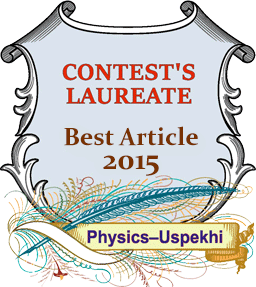 |
RSS feeds |
|
|||||
| Issue 12, 2025 |
|
||||||
|
|
|
||||||
Issues/2015/May |
← → |
| Reviews of topical problems |
The Hall effect and its analogs
a Institute for High Pressure Physics, Russian Academy of Sciences, Kaluzhskoe shosse 14, Troitsk, Moscow, 108840, Russian Federation
b National Research Centre ‘Kurchatov Institute’, pl. akad. Kurchatova 1, Moscow, 123182, Russian Federation
c Moscow Institute of Physics and Technology (National Research University), Institutskii per. 9, Dolgoprudny, Moscow Region, 141701, Russian Federation

We draw attention to the similarity between mutually related kinetic material phenomena that are odd in magnetic field and produce an electric current or heat flow perpendicular 1) to the magnetic field, 2) to the electric field, or to the temperature gradient. These phenomena include the Hall effect, the Righi-—Leduc effect in nonmagnetic metals, the anomalous Hall effect in magnets, the odd Senftleben—Beenakker effect in molecular gases and the phonon Hall effect in dielectrics. While these phenomena have much in common in terms of geometry, their formation mechanisms — dynamic and dissipative — are different. However, in all the cases the flow perpendicular to the magnetic field arises from the spin-orbit interaction of carriers with magnetic moments.
|
Keywords: Hall effect, anomalous Hall effect, spin Hall effect, phonon Hall effect, Righi—Leduc effect, Senftleben—Beenakker effect
PACS: 34.10.+x, 72.15.Gd, 72.15.Jf, 72.20.My, 72.20.Pa () DOI: URL: https://ufn.ru/en/articles/2015/5/b/  000360073200002 000360073200002  2-s2.0-84938829206 2-s2.0-84938829206  2015PhyU...58..446B 2015PhyU...58..446B Citation: Barabanov A F, Kagan Yu M, Maksimov L A, Mikheyenkov A V, Khabarova T V "The Hall effect and its analogs" Phys. Usp. 58 446–454 (2015) Received: 1st, March 2015, accepted: 17th, March 2015 Îðèãèíàë: Áàðàáàíîâ À Ô, Êàãàí Þ Ì, Ìàêñèìîâ Ë À, Ìèõååíêîâ À Â, Õàáàðîâà Ò Â «Ýôôåêò Õîëëà è åãî àíàëîãè» ÓÔÍ 185 479–488 (2015); |
|
© 1918–2025 Uspekhi Fizicheskikh Nauk Email: ufn@ufn.ru Editorial office contacts About the journal Terms and conditions |